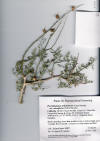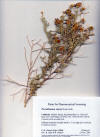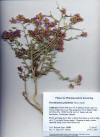|
Psorodendron arborescens
|
Psorodendron arborescens |
Psorodendron arborescens |
|
Psorothamnus emoryi
|
Psorothamnus emoryi |
Psorodendron fremontii
|
|
Psorothamnus polydenius
|
Psorothamnus polydenius |
Psorodendron schottii |
|
Psorothamnus scoparius
|
Psorodendron spinosum |
Psorodendron spinosum
|
|
Trees and Shrubs of Kern County (Jan 2013 2023, Dec 2024) Psorodendron Rydberg (1919) includes Psorothamnus sections Capnodendron Barneby (1977, Ps. spinosus), Winnemucca Barneby 1977 (Ps. kingii), and Xylodalea (Wats. Barneby 1977 (Ps. arborescens, Ps. fremontii, Ps. schottii) in the DNA phylogeny published by Urrego et al. (2023). The species in California may be distinguished by the fruit 6-10 mm in contrast to 2-4 mm in Psorothamnus emoryi and Ps. polydenius (Urrego et al. 2023; Jepson eflora). Varieties not distinguished in Urrego et al. (2023). Key to species of Psorodendron in Kern County Fruit with few scattered large glands; leaves green hairy Psorodendron arborescens Fruit with many small glands ± in rows; leaves silvery ....... Psorodendron fremontii Psorodendron arborescens (Torrey ex A. Gray 1854) Rydberg (1919). Dalea arborescens Torr. ex A. Gray var. minutifolius (Parosela johnsonii var. minutifolia Parish 1913), Psorothamnus arborescens (Torr. ex A. Gray) Barneby 1977. Johnson's dalea. Aromatic spiny-stemmed shrub with many shortly divided branches, usually from 0.5–2 m high; stems and leaves with conspicuous dotted glands; leaves alternate, divided pinnately into 5–7 leaflets with either 2 or 3 pairs along the main axis, and an odd terminal leaflet; flowers Apr-May, purple, calyx 5–6.8 mm; fruit (camara) shaped somewhat like a dolphin with a short to long curved beak, 7–10 mm long, with many conspicuous wart-like oil glands on the surface, indehiscent, 2-seeded. Common in the western Mojave Desert to the western border along the Sierra Nevada in Tulare, Kern Cos and Los Angeles Cos, across the Mojave Desert to southern Nevada. Type from Panamint Canyon, Inyo Co., CA. Although Barneby indicated that the plants are not tree-like (arborescent), they appear that way along the desert foothills of the San Bernardino Mts. (pers. obs.). Kern Co.: Jawbone Canyon, Red Rock Canyon, Pine Tree Canyon; Ricardo, Indian Wells Canyon, Short Canyon, 685–1,006 m (CCH). Roots collected along the desert slopes of the southern Sierra Nevada in Inyo Co. along the Kern County line showed leishmanicidal activity; many novel active flavones isolated (Salem & Webovertz, J. Nat. Prod. 68: 108–111, 2004; J. Nat. Prod. 69: 43–49, 2006). Spjut collected the original plant sample in July 1998, submitted it to J. M. Cassady at the Ohio State University, Sep. 2, 1999, recollected samples for Dr. Cassady in 2003 and again in 2005. Antiviral Plants: Chemical in Kern County Plant Could Treat COVID-19? Mimulus Memo: June 2020, pp. 6–11. Qamara et al. (2020, J. Pharmaceutical Analysis 10(4): 313–319) reported that this isoflavone “exhibited the highest binding affinity (−29.57 kcal/mol) and docking score (S = −16.35) among 32,297 screened as “potential antiviral phytochemicals” for treating COVID-19. Many papers continue to reference the compound for possibly treating COVID 19. Var. arborescens [Dalea fremontii var. saundersii (Parish) Munz 1935], distinguished by larger calyx (7–9 mm) and hairy leaflets, is reported from Randsburg and Red Rock State Park in CCH. Twisselmann indicated it was “occasional on slopes and canyons in the El Paso and Rand mountains, scarce on the high plains at the edge of the desert. Var. simplifolius (Parosela californica var. simplifolia Parish 1913) Barneby 1977, which has silky hairy leaflets that are “confluent” with the leaf axis, occurs further east and south of Kern Co., the nearest record to the county line is near Barstow. Psorodendron fremontii (Dalea fremontii Torrey ex A. Gray 1854) Rydberg 1919 [Psorothamnus fremontii Barneby 1977 var. fremontii]. Fremont's indigo bush. Differs from Ps. arborescens in having smaller and more numerous glands on the fruit to the extent that there is little space between glands in contrast to fewer and larger fruit glands of Ps. arborescens with more space between glands—equal to diam. of gland. Type from Mountains of the Pah-Utah country. Eastern Mojave Desert in California to Utah and Arizona. Kern Co.: Reported by Moe from Red Rock Canyon. CCH specimens report it from near the mouth of the Last Chance Canyon in the Mohave Desert; 5 miles northeast of California City on Randsburg-Mojave Road, near interpretive center of Desert Tortoise Natural Area; El Paso Mountains, 2.5 miles from Mesquite Canyon, Jawbone Canyon, and Red Rock Canyon, 822–914 m (CCH, 2of 7 records). Paiute and Shoshoni prepared decoctions from roots for treating internal hemorrhages and for stomach troubles (Moerman). Roots collected by the author have led to isolation of novel active flavones (Manikumar et al., J. Nat.Prod. 52(4): 769–773, 1989). Psorodendron schottii (Torrey) Barneby 1977. Schott's indigo bush (named after Heinrich Schott). Primarily in the western Sonoran Desert of California south to El Mármol in central part of Baja California Norte, Mexico, extending east to Arizona. Kern Co. CCH: Western slope of the Southern Sierra Nevada. Short Canyon about 2 miles west of California highway 14, east base of the Sierra Nevada, Short Canyon ACEC, 1005 m, granitic soils, creosote scrub, 22 Apr 1995 (CAS1097573). [Jack Remfiel (30 Apr 1933) from “Kane Springs,” which corresponds to Koehn Dry Lake, near Cantil, record not retrieved Sep 2015]. Publications from screening extracts of Psorodendron (Psorothamnus) arborescens (var. minutifolius, Spjut 15357) and P. polydenius (Spjut 15358). Manar M. Salem and Karl A. Werbovetz. 2004. Antiprotozoal compounds from Psorothamnus polydenius, J. Nat. Prod. 68: 108–111. The authors report the first discovery of chalcones, based on screening against Leishmania donovani and Trypanosoma brucei. The chalcones (chalcone 1 and 2), and also dalrubone, “reduced the number of infected macrophages by at least 96%, while posing no toxicity to the host cell.” Manar M. Salem and Karl A. Werbovetz. 2006. Isoflavonoids and other compounds from Psorothamnus arborescens with antiprotozoal activities.. J. Nat. Prod. 69: 43–49. “Bioactivity-guided fractionation of the root extract of Psorothamnus arborescens yielded the new isoflavone 5,7,3',4'-tetrahydroxy-2'-(3,3-dimethylallyl)isoflavone (1a) and the new 2-arylbenzofuran 2-(2'-hydroxy-4',5'-methylenedioxyphenyl)-6-methoxybenzofuran-3-carbaldehyde (2), together with seven known compounds, including three isoflavones, fremontin (3a), glycyrrhisoflavone (4a), and calycosin (5), two pterocarpans, maackiain (6) and 4-hydroxymaackiain (7), one triterpene, oleanolic acid (8), and one chalcone, isoliquiritigenin (9). In addition, the structure of the isoflavone fremontin was revised using spectroscopic and chemical methods and was assigned the new structure 3a. The isoflavone 1a and the chalcone 9 displayed leishmanicidal activity with IC50 values of 13.0 and 20.7 microM, respectively, against Leishmania donovani axenic amastigotes. Calycosin (5) exhibited selective toxicity against Trypanosoma brucei (IC50 12.7 microM) compared to L. donovani amastigotes and Vero cells (IC50 100 and 159 microM, respectively). These results prompted us to test a small group of structurally related isoflavones for their antitrypanosomal activities. Genistein and 7,3',4'-trihydroxyisoflavone displayed promising activity (IC50 values 4.2 and 7.1 microM, respectively) and selectivity (IC50 versus Vero cells: 32.9 and 135 microM, respectively). These studies suggest that the isoflavone skeleton deserves further investigation as a template for novel antileishmanial and trypanocidal compounds.” See also http://www.ohiolink.edu/etd/send-pdf.cgi?osu1127103915 Other publications from recollections of Psorothamnus for isolation of bioactive compounds Belofsky G., R. Carreno, K. Lewis, A. Ball, G. Casadei and G. P. Tegos. 2006. Metabolites of the "smoke tree", Dalea spinosa, potentiate antibiotic activity against multidrug-resistant Staphylococcus aureus. J. Nat. Prod. 69(2): 261–264. “Two new 2-arylbenzofuran aldehydes (1 and 2) and three known phenolic compounds (3-5) were isolated from organic extracts of Dalea spinosa. These compounds were evaluated for their intrinsic antimicrobial activity and their ability to perform as multidrug-resistance inhibitors by potentiating the activity of known antimicrobials against a variety of pathogenic microorganisms. Compound 1 and its acetate derivative 6 exhibited no direct antimicrobial activity but enhanced the effect of the weak plant antimicrobial berberine when tested against Staphylococcus aureus. Additional potentiation assays with S. aureus overexpression and knockout isogenic efflux mutants for the NorA pump were done in order to assess whether the potentiating effects were associated with inhibition of this known pump mechanism.” Kumarihamy M, Tripathi SK, Khan S, Muhammad I. 2022. Schottiin, a new prenylated isoflavones from Psorothamnus schottii and antibacterial synergism studies between methicillin and fremontone against methicillin-resistant Staphylococcus aureus ATCC 1708. Nat Prod Res. 2022 Jun;36(12):2984-2992. doi: 10.1080/14786419.2021.1937157. Epub 2021 Jun 14. PMID: 34121536 Manikumar G., K. Gaetano, M. C. Wani, H. Taylor, T. J. Hughes, J. Warner, R. McGivney and M. E. Wall. 1989. Plant antimutagenic agents, 5. Isolation and structure of two new isoflavones, fremontin and fremontone from Psorothamnus fremontii. J Nat Prod. 52(4): 769–773. “Two new isoflavones, fremontin and fremontone, were isolated from roots of Psorothamnus fremontii (Fabaceae), a desert plant. Compound 1 has the structure 5'-(alpha, alpha-dimethylallyl)-5,7,2',4'-tetrahydroxyisoflavone; compound 2 is similar but also contains the 3'-(gamma,gamma-dimethylallyl) substituent. The alpha,alpha-dimethylallyl substituent is rarely observed, and the combination of the alpha,alpha- and gamma,gamma-dimethylallyl substituents is unprecedented. Both 1 and 2 were nontoxic toward Salmonella typhimurium and were both highly active in the inhibition of mutagenicity of ethyl methanesulfonate (EMS) at all concentrations tested. Compound 2 was more active than 1 in the inhibition of mutagenicity of 2-aminoanthracene (2AN) and acetylaminofluorene (AAF) toward S. typhimurium.” Valeriote F, C. K. Grieshaber, J. Media, H. Pietraszkewicz, J. Hoffmann, M. Pan, and S. McLaughlin 2002. Discovery and development of anticancer agents from plants. J. Exp. Ther. Oncol. 2(4): 228–236. “A novel in vitro assay for the discovery of anticancer agents was used to examine aqueous and organic extracts from 1847 plants collected mainly in the U.S. Southwest and West. The assay results were separated into 5 categories: inactive (62%), equally active (36%), equally active and potent (0.5%), solid tumor selective (1.4%), and human selective (0.8%). Extracts from the latter three categories were fractionated using the in vitro assay to biodirect each step. Psorothamnus emoryi extracts were solid tumor selective and yielded two active compounds upon fractionation: dalrubone and 5-methoxydalrubone. Calocedrus decurrens was equally active and potent and yielded deoxypodophyllotoxin as the active compound. Linanthus floribundus was human selective and yielded strophanthidin as the active compound. The potential of this assay to discover novel anticancer agents from the active extracts is discussed.” Waldon H. B., M. B. Jenkins, R. A. Virginia and S. E. Harding. 1989. Characteristics of Woodland Rhizobial Populations from Surface- and Deep-Soil Environments of the Sonoran Desert. Appl. Environ. Microbiol. 12: 3058–3064. “A collection of 74 rhizobial isolates recovered from nodules of the desert woody legumes Prosopis glandulosa, Psorothamnus spinosus, and Acacia constricta were characterized by using 61 nutritional and biochemical tests. We compared isolates from A. constricta and Prosopis glandulosa and tested the hypothesis that the rhizobia from a deep-phreatic rooting zone of a Prosopis woodland in the Sonoran Desert of southern California were phenetically distinct from rhizobia from surface soils. Cluster analysis identified four major homogeneous groups. The first phenon contained slow-growing (SG) Prosopis rhizobia from surface and deep-phreatic-soil environments. These isolates grew poorly on most of the media used in the study, probably because of their requirement for a high medium pH. The second group of isolates primarily contained SG Prosopis rhizobia from the deep-phreatic rooting environment and included two fast-growing (FG) Psorothamnus rhizobia. These isolates were nutritionally versatile and grew over a broad pH range. The third major phenon was composed mainly of FG Prosopis rhizobia from surface and dry subsurface soils. While these isolates used a restricted range of carbohydrates (including sucrose) as sole carbon sources, they showed better growth on a range of organic acids as sole carbon sources and amino acids as sole carbon and nitrogen sources than did other isolates in the study. They grew better at 36 degrees C than at 26 degrees C. The FG Acacia rhizobia from surface-soil environments formed a final major phenon that was distinct from the Prosopis isolates. They produced very high absorbance readings on all of the carbohydrates tested except sucrose, grew poorly on many of the other substrates tested, and preferred a 36 to a 26 degrees C incubation temperature. The surface populations of Prosopis rhizobia required a higher pH for growth and, under the conditions used in this study, were less tolerant of low solute potential and high growth temperature than were phreatic-soil isolates. SG Prosopis rhizobia from phreatic and surface soils were physiologically distinct, suggesting adaptation to their respective soil environments.” Yu Q, Ravu RR, Xu QM, Ganji S, Jacob MR, Khan SI, Yu BY, Li XC.2015. Antibacterial Prenylated Acylphloroglucinols from Psorothamnus fremontii. Zhang H, X. Li, C. L. Ashendel and C. J. Chang. 2000. Bioactive compounds from Psorothamnus junceus. J. Nat. Prod. 2000 63(9): 1244–1228. “During a search for bioactive compounds from Psorothamnus junceus, four heterocyclic compounds, psorothamnone A (1), psorothamnone B (2), dalrubone (3), and emorydone (4) were isolated from the ethanol extract of the stem bark. Psorothamnones A (1) and B (2) demonstrated inhibitory activity against protein kinase C (PKC), a key enzyme involved in the signal transduction of cell proliferation and differentiation. Dalrubone (3) and emorydone (4) showed cytotoxicity against several human tumor cell lines.” Note: Psorothamnus junceus distinguished from Psorothamnus emoryi by chemotaxonomy (Spjut pers. comm. Chang) Taxonomic References Barneby RC. 1989. Psorothamnus Rydb. emend. Barneby. Intermountain Flora Vol. 3 (Pt. B): 29-32. Barneby, RC. 1977. Psorothamnus Rydberg. Mem. New York Bot. Gard. 27: 21-54, 598-607. Jepson Flora Project (eds.) 2024. Psorothamnus. Jepson eFlora, https://ucjeps.berkeley.edu/eflora/ [accessed on 23 December 2024] Kew: Plants of the World Online. Psorodendron arborescens. {Accessed 24 December 2024) McMahon M. 2005. Phylogenetic relationships and floral evolution in the papilionoid legume clade Amorpheae. Brittonia 57:397-411. https://cales.arizona.edu/~mcmahonm/pdfs/McMahon2005Brittonia.pdf McMahon M, Hufford L. 2004. Phylogeny of Amorpheae (Fabaceae: Papilionoideae). Amer. J. Bot.91(8):1219-1230. doi: https://doi.org/10.3732/ajb.91.8.1219
Rydberg, PA. 1919. North American Flora. Bronx, New
York, The New York Botanical Garden, Volume 24, Family Fabaceae: Tribe Psoraleae: Genus Psorodendron; p. 41–45. Urrego PP, H Suárez-Barón, N Pabón-Mora, F González. 2023. Reinstatement of the genus Psorodendron and related systematic novelties as revealed from phylogenetic analyses of the tribe Amorpheae (Leguminosae, Papilionoideae). Caldasia 45(1):49–65. http://doi.org/10.15446/caldasia.v45n1.96498. https://revistas.unal.edu.co/index.php/cal/article/view/96498/83717
|
||















